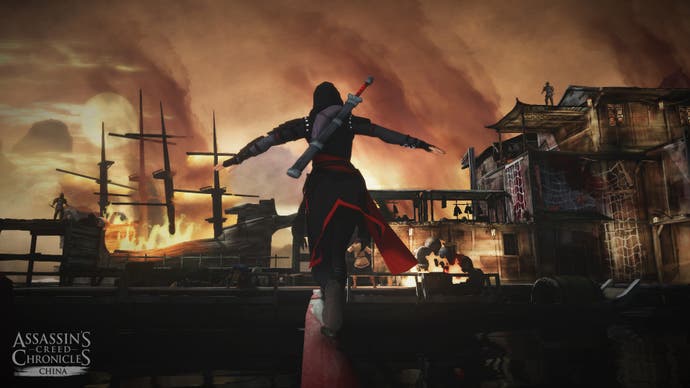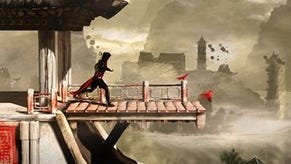Assassin's Creed Chronicles now a three-part series set in China, India, Russia
Hands-on with the 2.5D platformer.
Surprise! Assassin's Creed: Chronicles is now three games instead of one.

The previously-announced Assassin's Creed Chronicles: China, a side-scrolling action platformer developed by UK studio Climax, has now been revealed as just the first of three standalone downloadable episodes.
The mini-series' China episode will debut first on 22nd April (21st April in the US) and star Ming Dynasty-era assassin Shao Jun, after her meeting with Ezio in spin-off animation Assassin's Creed: Embers.
Episode two will follow with a tale set in India, 1841, featuring assassin Arbaaz Mir from the graphic novel Assassin's Creed: Brahman.
Finally, the third episode will be set in post-revolution Russia, in 1918, and star Nikolai Orelov from earlier graphic novels Assassin's Creed: The Fall and The Chain.
All episodes will be playable on their own, or together will form a loose story trilogy. Options will be available to buy each slice separately or together with a season pass.
The latter two episodes will launch "by autumn 2015". There's no change to the previously announced platforms of PC, PlayStation 4 and Xbox One.
Assassin's Creed: Unity director Alex Amancio broke the news to Eurogamer last year that more Chronicles episodes were planned. At the time, Amancio mentioned an Egypt-themed episode, although it sounds like Ubisoft has decided to stick with more established characters, albeit in settings that are well suited to further exploration.
Now, in a new hands-on playtest, we were able to play a near-finished version of Chronicles' China episode, and an early level set in India.
Regardless of their setting, each character is armed with a rope dart to swing across gaps and make the jump between various platforming planes - you're frequently tasked with areas that feature foreground and background elements.
Areas where leaps or other Assassin acrobatics are needed are accented by the colour red - similar to Mirror's Edge. Otherwise, the side-scrolling experience is heavily set-dressed in familiar Assassin's Creed style, with high buildings to leap off of, chests to pilfer and animus shards to collect.
The fighting style, while simplified, is also unmistakably based around Assassin's Creed. Each protagonist holds a hidden blade, a ranged weapon (the rope dart for Shao Jun, a chakram for Arbaaz and a rifle for Nikolai), and can access Eagle Vision to detect enemies and see their patrol routes.
Each episode has its own visual aesthetic, with the first based heavily around Chinese watercolours and broad splashes of ink. The episode in India features pencil lines and archaic newspaper print mixed with flourishes of lotus flowers when Arbaaz leaps across the screen. Finally, Nikolai's early 20th century adventure is styled around the bold colours of revolutionary propaganda and the monochrome backdrop of early black and white photography.

While each looks different, the three largely play the same. The series' Chinese opener includes an extended tutorial, something which developer Climax has said it will condense in later episodes, even though the series can be played in any order. Running and crouching is performed with the shoulder buttons, while tapping A allows you to jump. Hitting A at the right time, just before the edge of a building or while vaulting across platforms gifts you a fluid, speedy, onward movement.
But while the mechanics feel similar across the series, the levels themselves can vary - from time-sensitive platforming sections where your only objective is to keep racing through as crumbling columns collapse around you, to areas littered with enemies which you have to pick a careful path through.
The game can be completed using simple fight mechanics (X to assassinate from ledges or hidden in cover, LB and RB to aim and target weapons from afar) there are greater accolades to be won if you take areas via stealth. And the moments where you pull off the last kill in a level once swarming with enemies - with no one spotting you and setting off any alarms - are probably the most rewarding.
More than, to be honest, any recent Assassin's Creed game, Chronicles' stealth sections allow you to feel like a real blade in the shadows. Shimmying into cover against pillars or into the background in darkened areas allows enemies to pass in front of you, and you to pop out and drag them into the gloom to their deaths. Or you can whistle, fire distractions or smoke bombs into groups of enemies to send them trotting off the wrong way while you slip by unseen. Oh, and you can pick up and hide bodies again - something that Unity left out completely.
A major part of the game is avoiding the patrolling guard's vision cones, which for once give you a clear indicator of how far an enemy's sightline stretches. Not that this always makes a lot of sense - you can be creeping down a corridor in plain sight and still be just out of vision range - but it always feels fair to the player when you have been caught (which in other Assassin's experiences isn't always the case).

Later levels offer more room to explore, with large areas that must be picked through carefully to slowly unlock new routes to progress. It's not quite Metroidvania - there's no hint that, once complete, areas will need to be revisited, and the story of each episode is such that areas serve to propel the characters forward. But players who are fans of Assassin's Creed will relish the opportunity to spend more time with some fan-favourite spin-off faces - and even a brief re-appearance of an aged Ezio Auditore in flashback form (although sadly not voiced by regular actor Roger Craig Smith).
Shao Jun's story finally sheds more light on the mysterious box passed to her by Ezio back in the Embers film - something that fans have speculated about for several years. Its contents - a First Civilisation artefact - act as a macguffin for her storyline, as she clashes against a group of Templar-funded enemies seeking to control the country via a puppet emperor.
There's certainly plenty for fans of the franchise to sink their teeth into, and Chronicles' stealth sections are genuinely fun to plot your way past. But the action is less engaging in timed modes and when in open combat, where the similarites between characters and settings begin to show through. But both India and Russia are still to be completed, and it remains to be seen what else Climax has kept in store.

This article is based on a press event in Paris. Ubisoft paid for travel and accommodation.















